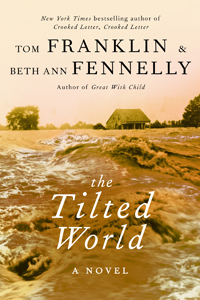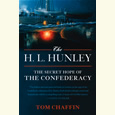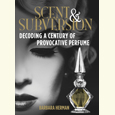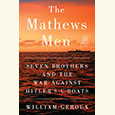A Flood of Emotion
The Tilted World, a novel by Beth Ann Fennelly and Tom Franklin, sets romance and suspense against the great Mississippi flood of 1927
In One Summer: America, 1927, nonfiction writer Bill Bryson calls the Mississippi flood of 1927 “the most epic natural disaster in American history in extent, duration, and number of lives affected.”After literally months of rain in the winter and spring, the Mississippi remained above flood stage for 153 consecutive days. Thousands died, and more than half a million people were left homeless. A state of hopelessness—and often lawlessness—dominated the flooded towns and farms bordering the river. This watery waste land, in the form of the fictional river town of Hobnob, Mississippi, becomes the setting for The Tilted World, a novel of romance and suspense by Beth Ann Fennelly and Tom Franklin.
 The book tells the parallel stories of Dixie Clay Holliver, the young, disillusioned wife of a smooth-talking moonshiner prone to violence, and Ted Ingersoll, a blues-loving Prohibition agent. Ingersoll reports directly to Commerce Secretary Herbert Hoover, who has been placed in charge of flood relief (an opportunity he expects to catapult him to the U.S. presidency). In alternating chapters reminiscent of Charles Frazier’s Cold Mountain, the two protagonists move steadily toward each other. As the crest of the flood flows inexorably toward Hobnob, along the way bursting levees like overripe fruit, wealthier planters and towns hire saboteurs to dynamite even more levees to the north of them, in hopes that their own lands will be saved. Hoover orders lines of armed guards to protect the levees throughout Mississippi and dispatches a pair of special agents—Ingersoll and his longtime partner, Ham—to locate a pair of missing revenue agents last seen in Hobnob and presumed murdered.
The book tells the parallel stories of Dixie Clay Holliver, the young, disillusioned wife of a smooth-talking moonshiner prone to violence, and Ted Ingersoll, a blues-loving Prohibition agent. Ingersoll reports directly to Commerce Secretary Herbert Hoover, who has been placed in charge of flood relief (an opportunity he expects to catapult him to the U.S. presidency). In alternating chapters reminiscent of Charles Frazier’s Cold Mountain, the two protagonists move steadily toward each other. As the crest of the flood flows inexorably toward Hobnob, along the way bursting levees like overripe fruit, wealthier planters and towns hire saboteurs to dynamite even more levees to the north of them, in hopes that their own lands will be saved. Hoover orders lines of armed guards to protect the levees throughout Mississippi and dispatches a pair of special agents—Ingersoll and his longtime partner, Ham—to locate a pair of missing revenue agents last seen in Hobnob and presumed murdered.
As Dixie Clay rides a mule through Hobnob, contemplating whether or not her husband may have committed a double murder, trying not to think of the infant she lost to a fever two years earlier, she pauses to watch workers battling to save the levee. “Will it hold, will it hold, will it hold? That was the question asked a thousand times a day,” she thinks. As Dixie Clay’s history unfolds in the story’s rising action, this question seems to apply to her own life as much as to the leaking levee.
Not long afterward, Ingersoll throws away a pair of ruined boots and waits for his partner to emerge from a shoe store. “[H]e lit a cigar and leaned against the post and gazed at a sky the color of old dimes sliced by a levee that backed around the river’s curve, higher than the two-story buildings the next street over, and he thought of living next to such a structure, a massive mound of earth walling out the mightiest of rivers. Until it couldn’t anymore.”
 Thus, before they ever meet, Dixie Clay and Ingersoll are clearly being pulled together with the gravity of surging floodwater; they will absolutely need one another to escape not only their current lives but also certain death. The flood moves beyond solid historical fact and well-rendered setting, becoming the book’s central metaphor. Only heroic struggle against it can save the protagonists. The ruined South, drenched first by bathtub gin and then by the mud and might of the Mississippi, is the nightmarish landscape through which the couple must navigate toward salvation.
Thus, before they ever meet, Dixie Clay and Ingersoll are clearly being pulled together with the gravity of surging floodwater; they will absolutely need one another to escape not only their current lives but also certain death. The flood moves beyond solid historical fact and well-rendered setting, becoming the book’s central metaphor. Only heroic struggle against it can save the protagonists. The ruined South, drenched first by bathtub gin and then by the mud and might of the Mississippi, is the nightmarish landscape through which the couple must navigate toward salvation.
The crest of the flood arrives simultaneously with a cloaked saboteur and all the essential clues to the murder, setting up a breathless climax that is by turns gripping and unexpectedly emotional. “Dixie Clay was lifted toward the waking world on a surge of pain,” one chapter begins. “She would have ridden it down again into the black oozing warmth but some idea of an idea, some thought she had to think, wrenched her, torqued her out, she was gasping like a crappie thrown up on the levee and left to die.”
Beth Fennelly and Tom Franklin, who are married to each other, teach in the M.F.A. creative-writing program at the University of Mississippi. Franklin, the author of Crooked Letter, Crooked Letter, among other novels and stories, has long chronicled the seamier side of Mississippi life. His characters tend to resemble Faulkner’s Snopeses, though as Cormac McCarthy might have imagined them. The title story of Franklin’s first collection, Poachers, won the Edgar award from the Mystery Writers of America, and his work tends to be propelled by a rising threat of violence, even when his prose is at its most haunting and evocative. Fennelly, in contrast, is a poet and also the author of Great with Child: Letters to a Young Mother, a highly praised collection of letters written to a pregnant friend; it is filled with motherly advice that is both funny and informative.
This mix turns out to be ideal for a story that is by turns romantic and suspenseful, rich in carefully researched historic detail yet full of surprisingly light touches depicting life in the Jazz Age South. As two highly skilled writers, each intimately familiar with the other’s work, Fennelly and Franklin blend their voices flawlessly. As Dixie Clay muses near the end, speaking to imaginary grandchildren, “[M]ost of all, this is a love story.”
Beth Ann Fennelly and Tom Franklin will read from The Tilted World at Burke’s Book Store in Memphis on October 4, 2013, at 5 p.m. The pair will also discuss the novel at the twenty-fifth annual Southern Festival of Books, held in Nashville October 11-13, 2013. Both events are free and open to the public.


